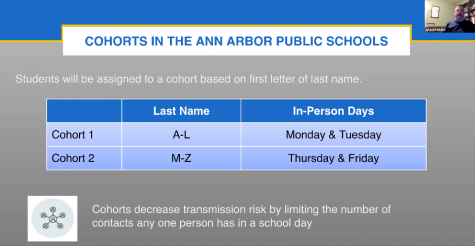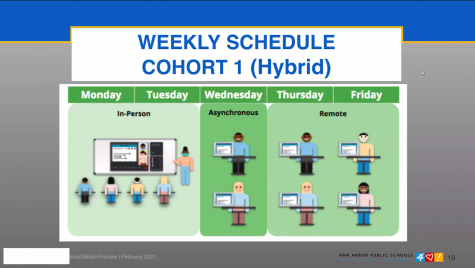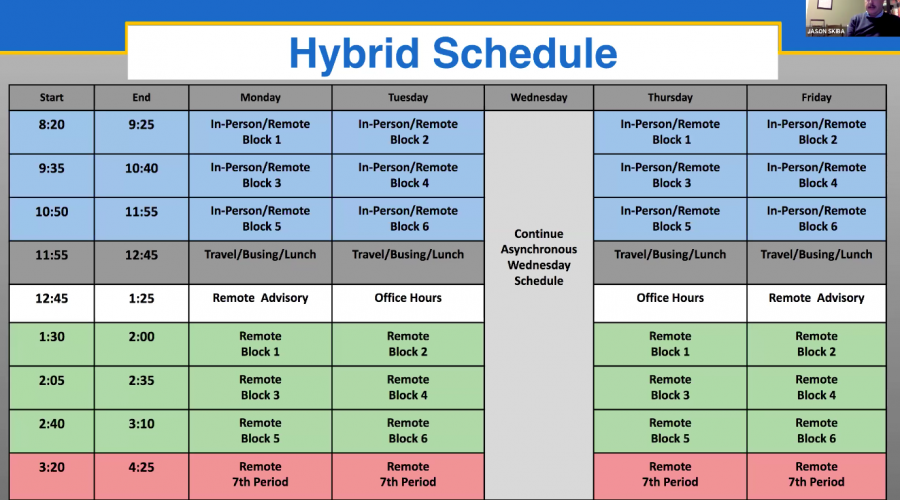Hybrid Learning: The planned schedule
On Feb. 24, after weeks of back-and-forth discussions, the Ann Arbor Public Schools Board of Education voted for schools to start hybrid learning. The “AAPS phased approach,’ as referred to by Pioneer principal Tracey Lowder, means that students in preschool, young fives, kindergarten, and self-contained classrooms students will be back in the school buildings first. Weeks later, two rounds of elementary schoolers and middle and high schoolers would return on on April 19.
But this plan raised another question:
What will hybrid learning actually look like?
Schedules for Pioneer students this year have looked different than usual, with three to four classes a day plus advisory on a block schedule instead of the typical six or seven classes that the school offers in a non-virtual year. Many expected this change was to carry over when schooling switched to hybrid.
However, a recent update from the AAPS Board of Education says otherwise.

Many students had previously been aware that there would be two cohorts, the first one for last names A-L and the second for last names M-Z, and were aware that each cohort would go into the school building twice a week. While the basis of this is still true, several logistics have been tweaked.
First off, the school day is going to start ten minutes earlier than it previously has this year at 8:20 a.m. instead of 8:30 a.m., and end ten minutes earlier (at 3:10 p.m. for students with six classes excluding advisory, and 4:25 p.m. for students with seven classes excluding advisory).
Second, students who choose to go hybrid will only be in the physical building for around seven hours each week. Hybrid students will be in the building from 8:20 to 11:55, after which there will be a 50-minute period to get home, eat lunch, and set up for afternoon classes, which will be fully virtual. Students in self-contained programs will remain in-person all day.
Cohort 1 will do this on Monday and Tuesday and Cohort 2 on Thursday and Friday, with Wednesday staying asynchronous. This way, students will be able to have all their classes, except seventh hour and advisory, in person. Students will not be on Zoom in the classroom, but Schoology will continue to be used. Students choosing to remain at home will stay virtual as usual.

Lastly, the overall layout of the schedules will change. Odd-numbered blocks (first, third, and third hours) will occur twice a day on Mondays and Thursdays for 65 minutes in the morning and againfor only 30 minutes each in the afternoon virtually. The same will be the case for even-numbered blocks (second, fourth, and sixth hours) on Tuesdays and Fridays. The format for seventh hour has not been included in this switch and will still only be held once a day.
In an email to middle and high schools regarding the new plan, Superintendent Swift said, “We have maintained the priority of the health and safety of our students, staff, and families throughout this COVID time, and this commitment will continue. We are committed to accomplishing this return to school buildings safely while also focusing on our critical mission to teaching learning, and serving our students and families.”
Some students took to social media to express their concerns about going back to in-person school, considering it is relatively near the end of school and Advanced Placement tests.
However, College Board is now offering three different time slots for these tests, and AAPS has chosen to take the latest one, meaning that AAPS students will not be taking their AP tests until early to mid June.
Additionally, Governor Gretchen Whitmer announced on Friday, March 12, that all Michiganders 16 and older will be eligible to receive the COVID-19 vaccine starting April 5, though it may take multiple weeks to get an appointment.
Lowder expressed the excitement of himself and the Pioneer staff about returning to in-person school. “The Pioneer staff is anxious to return to the building and get back at least a little bit of what we’re most familiar with: an environment full of teaching and learning.”


